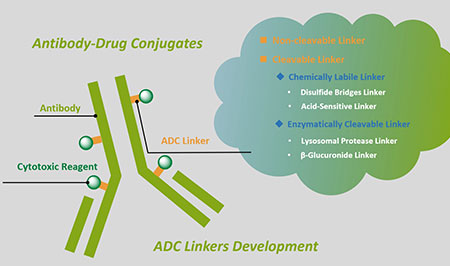1. EGFR Targeted Cetuximab-Valine-Citrulline (vc)-Doxorubicin Immunoconjugates- Loaded Bovine Serum Albumin (BSA) Nanoparticles for Colorectal Tumor Therapy
Yanyan Liu, Yuanfen Liu, Yue Zhang, Jiasheng Tu, Zixuan Ye, Yan Shen Int J Nanomedicine . 2021 Mar 26;16:2443-2459. doi: 10.2147/IJN.S289228.
Background:Specific modifications to carriers to achieve targeted delivery of chemotherapeutics into malignant tissues are a critical point for efficient diagnosis and therapy. In this case, bovine serum albumin (BSA) was conjugated with cetuximab-valine-citrulline (vc)-doxorubicin (DOX) to target epidermal growth factor receptor (EGFR) and enable the release of drug in EGFR-overexpressed tumor cells.Methods:Maleimidocaproyl-valine-citrulline-p-aminobenzylcarbonyl-p-nitrophenol (MC-Val-Cit-PAB-PNP) and DOX were used to synthesize MC-Val-Cit-PAB-DOX, which was further linked with cetuximab to prepare antibody-drug conjugates (ADCs). Then, the ADCs were adsorbed to the surface of the BSA nanoparticles (NPs), which were prepared by a desolvation method to obtain cetuximab-vc-DOX-BSA-NPs. The cetuximab-vc-DOX conjugates adsorbed on the surface of the BSA nanoparticles were determined and optimized by size exclusion chromatography. An in vitro cytotoxicity study was conducted using a colon carcinoma cell line with different EGFR-expression levels to test the selectivity of cetuximab-vc-DOX-NPs.Results:The vc-DOX and cetuximab-vc-DOX conjugates were both synthesized successfully and their structural characteristics confirmed by1H-NMR and SDS-PAGE. The MTT assay showed stronger cytotoxicity of cetuximab-vc-DOX-NPs versus control IgG-vc-DOX-NPs in EGFR-overexpressing RKO cells. Cellular binding and intracellular accumulation determined by flow cytometry and confocal laser scanning microscopy revealed the strong binding ability of cetuximab-vc-DOX-NPs to RKO cells. The in vivo imaging study demonstrated that cetuximab-vc-DOX-NPs exhibited higher fluorescent intensity in tumor tissues than non-decorated nanoparticles (IgG-vc-DOX-NPs). In vivo tumor inhibition and survival tests showed that cetuximab-vc-DOX-NPs revealed higher tumor inhibition efficacy and lower systemic toxicity than control IgG-vc-DOX- NPs.Conclusion:The obtained results emphasize that cetuximab-vc-DOX-NPs, with good tumor-targeting ability and low systemic toxicity, are a promising targeting system for drug delivery.
2. Cryptophycin-55/52 based antibody-drug conjugates: Synthesis, efficacy, and mode of action studies
Weirong Lai, Mengdan Wu, Jinliang Yang, Lantu Gou, Hao Chen, Yuxi Wang, Yiwen Zhang, Ruixue Wang, Yujia Peng, Cuiyu Guo, Ruirui Zhang, Ying Lu, Yuyin Fu, Wei Liao, Qinhuai Lai, Yuqin Yao, Xiaohua Jiang, Lin Yu, Xin Wang, Tairan Kang, Zhixiong Zhang, Yiran Tao Eur J Med Chem . 2020 Aug 1;199:112364. doi: 10.1016/j.ejmech.2020.112364.
Cryptophycin-52 (CR52), a tubulin inhibitor, exhibits promising antitumor activity in vitro (picomolar level) and in mouse xenograft models. However, the narrow therapeutic window in clinical trials limits its further development. Antibody-drug conjugate (ADC), formed by coupling cytotoxic compound (payload) to an antibody via a linker, can deliver drug to tumor locations in a targeted manner by antibody, enhancing the therapeutic effects and reducing toxic and side effects. In this study, we aim to explore the possibility of CR52-based ADC for tumor targeted therapy. Due to the lack of a coupling site in CR52, its prodrug cryptophycin-55 (CR55) containing a free hydroxyl was synthesized and conjugated to the model antibody trastuzumab (anti-HER2 antibody drug approved by FDA for breast cancer therapy) via the linkers based on Mc-NHS and Mc-Val-Cit-PAB-PNP. The average drug-to-antibody ratios (DARs) of trastuzumab-CR55 conjugates (named T-L1-CR55, T-L2-CR55, and T-L3-CR55) were 3.50, 3.29, and 3.35, respectively. These conjugates exhibited potent cytotoxicity in HER2-positive tumor cell lines with IC50values at low nanomolar levels (0.58-1.19 nM). Further, they displayed significant antitumor activities at the doses of 10 mg/kg in established ovarian cancer (SKOV3) and gastric cancer (NCI-N87) xenograft models without overt toxicities. Finally, the drug releases were analyzed and the results indicated that T-L3-CR55 was able to effectively release CR55 and further epoxidized to CR52, which may be responsible for its best performance in antitumor activities. In conclusion, our results demonstrated that these conjugates have the potential for tumor targeted therapy, which provides insights to further research the CR55/CR52-based ADC for tumor therapy.







